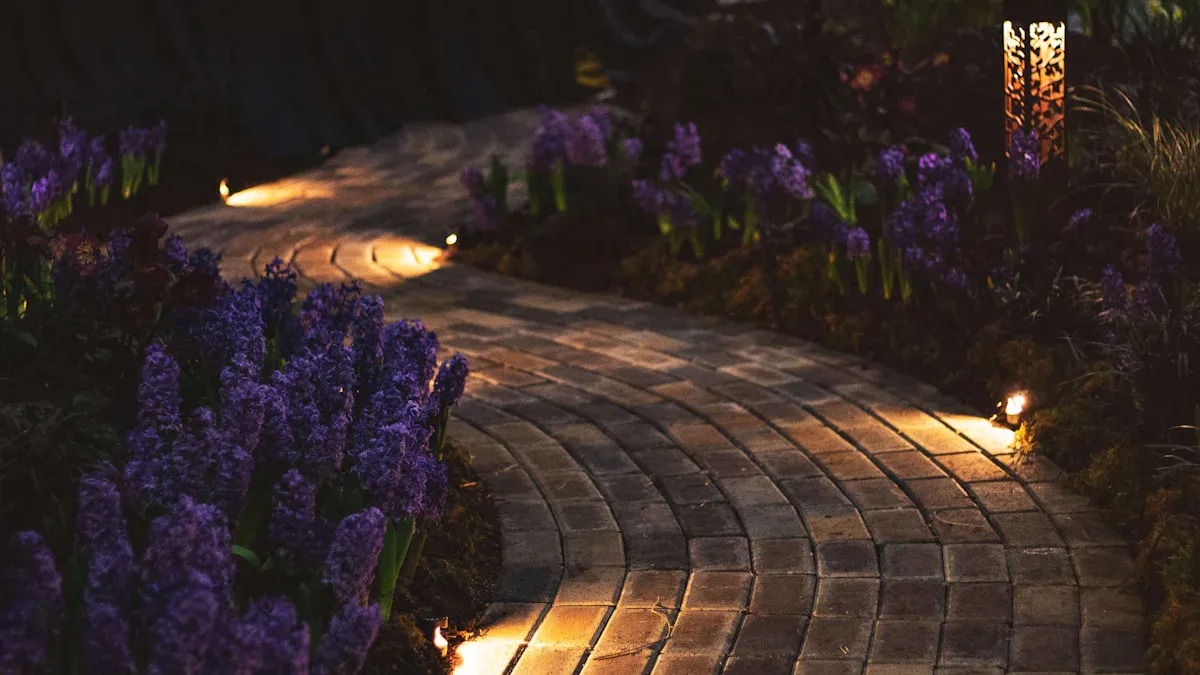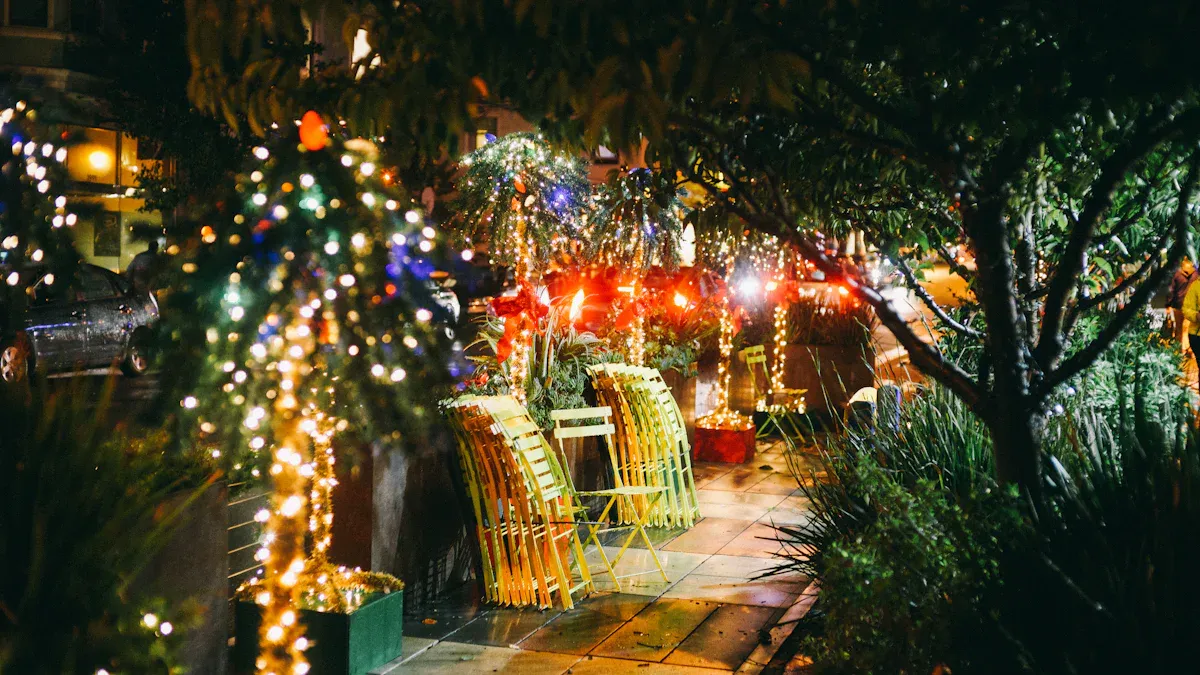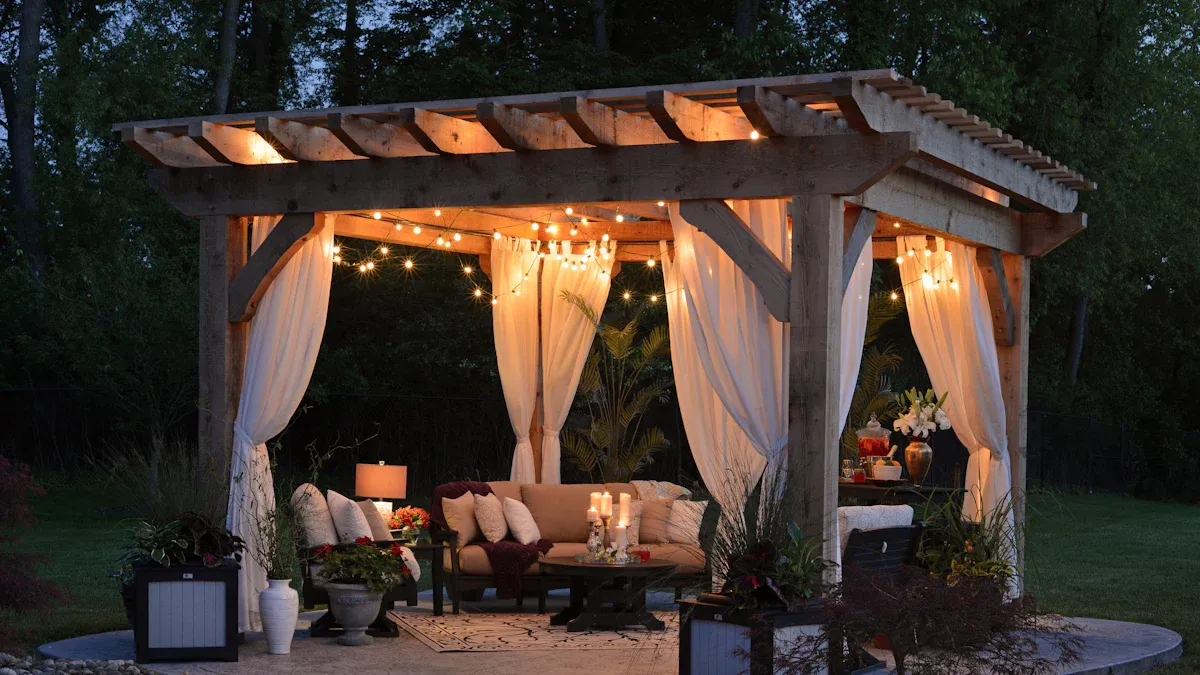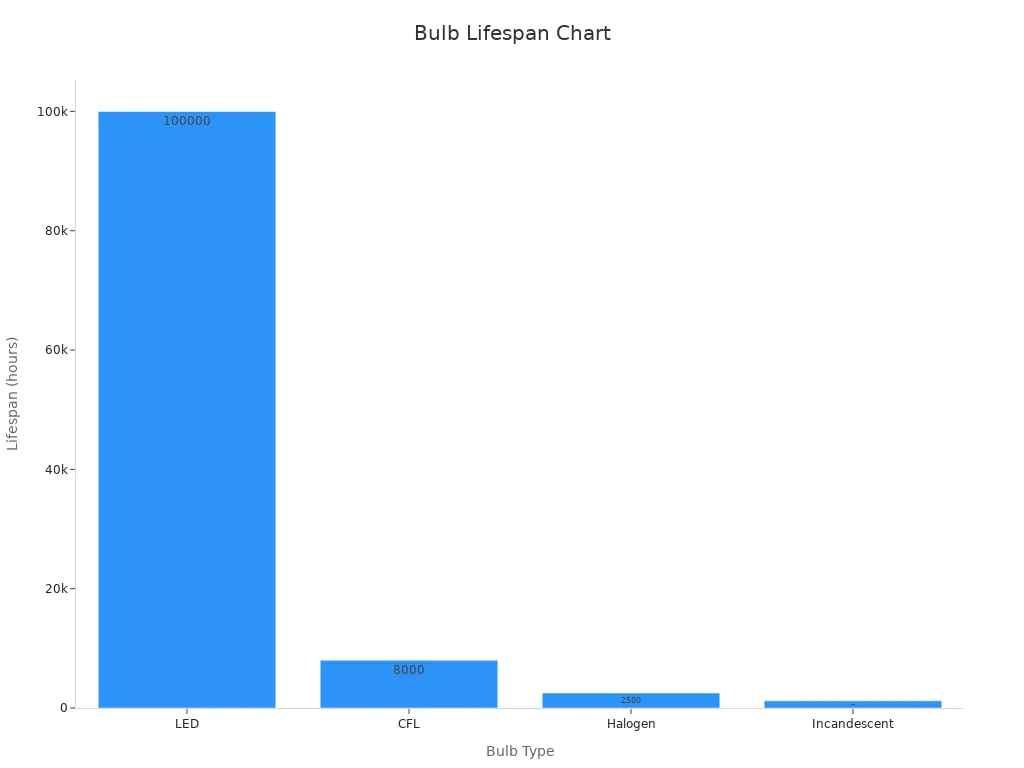Exterior Lighting: Enhancing Your Outdoor Space with Proper Illumination

Exterior lighting can transform your backyard into a welcoming space. When you step outside after dark, soft lights from the right product, such as a LED light, illuminate your surroundings beautifully. This not only makes you feel safe but also enhances the look of your home. Using quality exterior lighting, you can highlight plants, paths, and other features to create an outdoor area you truly enjoy. For more ideas and information about our products, visit our About Us page or explore the Home section on our website!
Key Takeaways
Good exterior lighting helps keep your yard safe. It also makes your yard look nice. You can use your yard at night more easily. Plan your lighting by looking at your space. Set clear goals for what you want. Map out zones to cover the area evenly. Use ambient, task, and accent lights together. This mix makes your outdoor space warm and useful. It also makes it feel welcoming. Pick LED bulbs that save energy. Choose fixtures that can handle bad weather. This helps you save money. Your lights will last longer. Take care of your lights often. Clean them and check for damage. Trim plants so your lights stay bright and safe.
Benefits of Exterior Lighting
Visual Appeal
When you add landscape lighting to your yard, you create a beautiful scene that stands out at night. You can use lights to highlight trees, flower beds, or water features. Many people love how outdoor lighting brings out the colors and shapes in their gardens. You might notice that your favorite plants look even better with a soft glow.
Tip: Try placing landscape lighting at different angles to see what looks best. Sometimes, a small change can make a big difference in how your space feels.
Safety & Security
You want your home to feel safe. With the right exterior lighting, you can light up walkways, steps, and driveways. This helps you and your guests avoid trips or falls. Landscape lighting also helps keep unwanted visitors away. When you use outdoor lighting to brighten dark corners, you improve safety and security for everyone at home.
Usability
You do not have to stop enjoying your yard when the sun goes down. Landscape lighting lets you use your patio, deck, or garden after dark. You can host a barbecue, play games, or just relax outside. Well-placed lights make it easy to see where you are going and what you are doing.
Use path lights to guide your way.
Add spotlights for cooking or reading.
Try string lights for a cozy touch.
Curb Appeal
First impressions matter. When you use landscape lighting, your home looks more inviting from the street. Neighbors and visitors will notice the warm glow and neat appearance. Outdoor lighting can even increase your home's value. If you ever decide to sell, buyers will love the extra charm that lights bring to your property.
Lighting Design

Assessing Your Space
Before you start picking out lights, take a good look at your outdoor area. Walk around your yard during the day and at night. Notice where you need more light and where you want to create a cozy mood. You can use both technical tools and your own eyes to check your space. For example, some people use special meters to measure how bright or colorful the light is in different spots. These tools help you see if you meet the right standards for safety and comfort. But your own feelings matter, too. Ask yourself, “Does this spot feel safe? Is it too dark or too bright?” When you combine these methods, you get a full picture of what your yard needs.
Tip: Try taking photos of your yard at night. This helps you spot dark corners or areas that could use a little extra glow.
Setting Goals
Now, think about what you want your lighting design to do. Do you want to show off your favorite tree? Maybe you want to make your walkway safer. Setting clear goals helps you choose the right lights and put them in the best places. Here are some best practices to help you set smart goals for your landscape lighting:
Decide what you do most outside. Do you eat, play, or relax? Your activities shape your lighting needs.
Think about when you use your yard. If you spend time outside at night, you may need brighter lights in some areas.
Make sure your lights help you feel safe and comfortable. Avoid glare and harsh shadows.
Balance beauty and function. Good lighting design should look nice and work well.
Talk with family or friends who use the space. They might have ideas you didn’t think of.
Use smart controls if you want to change the mood or save energy.
Remember, you want your lighting design to help you see, feel safe, and enjoy your yard.
Note: Setting goals makes it easier to pick the right landscape lighting and avoid wasting money on lights you don’t need.
Mapping Zones
Once you know your goals, it’s time to map out your zones. Divide your yard into different areas, like the patio, garden, driveway, and walkways. Each zone may need a different type of landscape lighting. Draw a simple map or sketch of your yard. Mark where you want to place each light. This step helps you see if your lighting design covers all the important spots without making the space too bright or too dark.
Use path lights along walkways.
Place spotlights on trees or garden beds.
Add soft lights near seating areas for a relaxing feel.
A good map keeps your exterior lighting balanced. You avoid dark patches and make sure every part of your yard feels welcoming. When you plan your zones, you also make it easier to install and maintain your lights later.
Remember: A thoughtful lighting design plan helps you enjoy your outdoor space every night. You get the right mix of safety, beauty, and fun.
Outdoor Lighting Types

When you plan your outdoor space, you want the right mix of light. Each type of lighting has a special job. You can use them together to make your yard look great and feel safe.
Ambient Lighting
Ambient lighting gives your yard its main glow. It sets the mood and helps you see where you are going. You might use string lights, lanterns, or built-in LEDs for this. These lights spread soft, even light across large areas like patios or decks.
To get the best results, you can follow a simple method:
Think about how you use the space. Do you eat dinner outside or just relax?
Check the IES foot candle guide for the right brightness level.
Multiply the foot candle number by the size of your area (in square feet). This gives you the total lumens you need.
Divide the total lumens by the number of lights you plan to use. Now you know how bright each light should be.
Look at the height of your ceiling or roof and the shape of your space. You may need to adjust the number of lights.
Tip: If you want a cozy feel, use warm white bulbs. For a modern look, try cooler tones.
Task Lighting
Task lighting helps you do things safely and easily. You use these lights for jobs like cooking, walking, or reading outside. Place them where you need extra brightness, such as near grills, steps, or garden paths.
Some good examples are:
Path lights along walkways
Spotlights over outdoor kitchens
Deck lights on stairs
Task lighting keeps you safe and makes your outdoor space more useful. You can enjoy your yard at night without worrying about tripping or missing a step.
Accent Lighting
Accent lighting lets you show off the best parts of your yard. You can use it to highlight a tree, a statue, or the texture of your home’s walls. Accent lights are usually brighter and more focused than other types.
When you use accent lighting, you want to think about a few things:
The amount and strength of light (measured in lumens, lux, or foot-candles) help you see how well the light shows off your feature.
Spread the light evenly so you do not get harsh shadows.
Pick the right color temperature. Warm tones make things feel cozy, while cool tones look bold.
Place your lights carefully. Aim them at columns, eaves, or textured walls to make those features pop.
Try uplighting to add drama and depth to your home’s outside.
The height and spot where you put your lights matter. You want to avoid dark spots or too much glare.
Note: Accent lighting can turn a simple garden into a stunning night scene. You can use solar stake lights, spotlights, or even small lanterns for this job.
Layering Techniques
You get the best results when you layer different types of landscape lighting. Layering means you use ambient, task, and accent lights together. This makes your yard look balanced and inviting.
Here’s how you can layer your lights:
Start with ambient lighting to set the overall mood.
Add task lighting where you need to see clearly, like on steps or near the grill.
Use accent lighting to draw attention to special features, such as a fountain or a beautiful tree.
Lighting Type | Purpose | Example Fixtures |
|---|---|---|
Ambient | General illumination | String lights, lanterns |
Task | Focused, practical use | Path lights, deck lights |
Accent | Highlight features | Spotlights, solar stakes |
When you layer your landscape lighting, you create a space that feels safe, looks beautiful, and works for any activity. You can enjoy your outdoor lighting every night, whether you are relaxing, playing, or showing off your garden.
Fixture Selection
Choosing Fixtures
Picking the right fixtures can make your landscape lighting stand out. You want to match the style of your home and garden. Some people like modern designs, while others prefer classic lanterns. Think about where you need lights most. Pathways, patios, and garden beds all need different types. Try to keep the look balanced. Too many lights can feel harsh, but too few can leave dark spots. Always check if your fixtures work well with the rest of your landscape lighting plan.
Bulb Options
Not all bulbs are the same. Some last longer and save more energy. Take a look at this table to compare the most common choices for landscape lighting:
Bulb Type | Lifespan (hours) | Energy Consumption Compared to Incandescent | Additional Notes |
|---|---|---|---|
LED | Up to 100,000 | 75% less energy | Lasts 25 times longer than incandescent |
CFL | ~8,000 | More efficient than incandescent, less than LED | Significant energy savings |
Halogen | ~2,500 | 25-30% less power than incandescent | Moderate energy savings |
Incandescent | ~1,200 | Baseline (least efficient) | Being phased out due to inefficiency |

LED bulbs work best for most outdoor lights. They last much longer and use less power. You will spend less money on replacements and electricity. This makes them a smart choice for landscape lighting.
Energy Efficiency
You want your landscape lighting to look great and save energy. Choose energy-efficient lighting to lower your bills and help the planet. Look for bulbs with high lumens per watt. ENERGY STAR labels also show you which products use less power. LEDs are the top pick for energy savings. They give you bright light without wasting electricity. Over time, you will notice the difference in your energy costs.
Weather Resistance
Outdoor lights face rain, wind, and sun every day. You need fixtures that can handle tough weather. Here are some things to check:
IP ratings show how well a fixture keeps out water and dust. The first number is for solids, the second for liquids.
Pick at least IP44 for most outdoor areas. This protects against splashes from any direction.
Use IP65 or IP67 for places with heavy rain or direct water.
Stainless steel and high-grade plastics resist rust and last longer.
Strong materials and good IP ratings mean less fixing and longer life for your landscape lighting.
Tip: Always check the product label for weather ratings before you buy new lights.
Installation & Care
DIY vs. Professional
You might want to put in landscape lighting by yourself. Many people like doing DIY projects at home. Some outdoor lights are simple to install. Solar stake lights or plug-in string lights are easy to set up. You only need a few steps to get them working. If you want to use hardwired fixtures or low voltage systems, you may need help. Electricians know how to work with wires safely. They also follow local rules for wiring. They can stop problems before they start. If you are not sure what to do, ask a professional for help.
Tip: Try small projects first. You can add more landscape lighting later as you learn.
Safe Installation
Safety is very important when you put in landscape lighting. You want to keep your home and family safe. Always use fixtures made for outside. Look for products with safety marks. Here is a quick table of some important standards:
Standard / Code | Application Area | Safety Focus / Requirements | Additional Notes |
|---|---|---|---|
UL 1598 | Line voltage luminaires | Wet location, fire risk, electric shock, ingress protection | Tested for UV and low temperature durability |
UL 1838 | Low voltage landscape lighting systems | Fire and electric shock risk for power units | Power units limited to 15 Vac or 30 Vdc |
UL 2108 | Low voltage lighting systems | Low voltage lighting components | Supports field mating of parts |
UL 8801 | Photovoltaic-powered lighting systems | Battery and power management, fire risk | Includes outdoor performance tests |
When you put up wall lights, keep them 66 to 72 inches high. This helps light the path but does not shine in your eyes. For deck safety, put recessed lights on steps and edges. Always turn off the power before you touch any wires.
Maintenance Tips
Landscape lighting works better if you take care of it. Clean your lights every few months to get rid of dirt and bugs. Check for loose wires or bulbs that do not work. Change any broken parts right away. After storms, walk around and check if all your lights work. Cut back plants that block the light. If you use solar lights, wipe the panels so they get enough sun. Taking care of your lights keeps your landscape lighting bright and safe for a long time.
Note: A little care helps a lot. You protect your lights and keep your outdoor space looking nice.
With the right lighting, your outdoor space can feel amazing. Good lighting makes your yard look nice and helps keep your family safe. It also lets you have more fun outside at night. Even just a few path lights can change how your yard looks. If you want to do a bigger project, you can ask a professional for help. You should have an outdoor area that feels safe and welcoming.
FAQ
How do you choose the right brightness for outdoor lights?
You want enough light to see but not so much that it feels harsh. Check the lumens on the package. For walkways, 100-200 lumens work well. For patios, try 200-400 lumens.
Can you install outdoor lighting yourself?
Yes, you can install many outdoor lights on your own. Solar and plug-in lights are easy. For hardwired lights, you may want to call a professional. Always follow safety tips.
What is the best way to save energy with outdoor lighting?
Use LED bulbs. They last longer and use less power. Add timers or motion sensors. These turn lights off when you do not need them. Solar lights also help you save energy.
How do you keep outdoor lights working well?
Clean your lights every few months. Wipe off dirt and bugs. Check for loose wires or broken bulbs. Trim plants that block the light. Replace any damaged parts right away.
See Also
Effective Outdoor Commercial Lighting For Safety And Style
Minimizing Light Pollution With Dark Sky Outdoor Lighting
Selecting Ideal Exterior Lighting Fixtures Based On Business Needs
Outdoor Sign Lighting: Methods, Uses, And Expert Recommendations
Optimizing Recessed Ceiling Lighting To Highlight Design Elements

